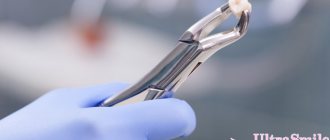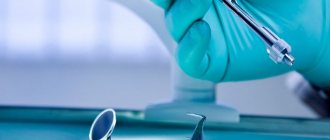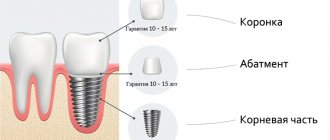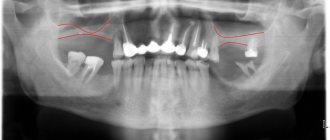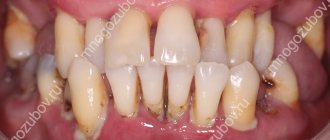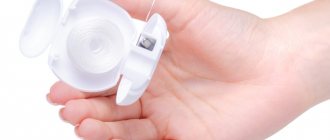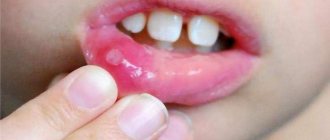Installation of dental implants is the most progressive method of dental prosthetics. This technology ensures the greatest completeness of restoration of dental functionality, maximum comfort for the patient and almost complete similarity of dentures to natural teeth.
Currently, various types of implants are used and different methods of their installation are practiced. However, regardless of the design of the implant and the method of its implantation, implantation is a risky procedure. Firstly, there is a danger of complications during the operation itself due to medical errors or other reasons. Secondly, there is a possibility of implant rejection even many years after their implantation into the bone.
Therefore, during the operation, great care is required from the doctor, and after implantation, the patient must strictly adhere to the prescribed regimen, especially during the rehabilitation period.
A common cause of various complications after implantation is the penetration of infection into the tissue, which, against the background of the general weakening of the patient’s body due to the surgery, becomes especially aggressive and dangerous. The result can be inflammation of both the soft tissues adjacent to the prosthesis and the bone. This results in implant rejection, often resulting in the need to remove it. Therefore, during implantation, in order to prevent and treat infection, antibacterial therapy is carried out using antibiotics.
General overview of the operation
Installation of implants is a complex surgical operation that is carried out in one or several stages. It all depends on the complexity of the case and individual preferences.
Before starting work, the doctor conducts a thorough diagnosis of the patient. This allows you to determine whether there are contraindications to surgery.
Often, when installing dental implants, additional operations such as osteoplasty are performed. During the surgical procedure, artificial bone tissue is built up. This allows you to give the new tooth stability.
When restoring the dentition in this way, the gums are dissected. Through the incision, pathogenic microorganisms can enter the body, which can cause serious problems in the future.
To avoid complications, the doctor prescribes a course of antibiotic drugs, the main purpose of which is:
- prevention of the development of inflammatory processes during surgical intervention;
- acceleration of bone tissue recovery and osseointegration.
A course of therapy is prescribed only after a preliminary collection of the patient’s medical history, which will make it possible to establish the presence of contraindications to taking certain antibiotics.
Let's discuss together all the pros and cons of dental implantation and innovative techniques.
Read here why sutures come apart after dental implantation and how to prevent complications.
At this address we will talk about the features of implantation of anterior teeth.
The effect of surgery on the body
Dental implantation is, although not extensive, a rather complex operation that involves the implantation of a foreign object into the jaw bone.
Soft gum tissue and periosteum are also manipulated. The operation consists of several stages:
- dissection of soft gum tissue;
- removal of part of the periosteum and drilling of a channel for the implant;
- installation of an implant in the hole made;
- stitching of gum tissue.
At all stages of surgery, there is a high probability of microorganisms entering the surgical area, which persists in the postoperative period.
The penetration of microbes into a surgical wound is associated with the risk of developing infectious complications, both in the wound itself and in distant organs, where microbes can be carried through the bloodstream.
The presence of an implant changes the pathophysiology of the wound process and increases the likelihood of infectious complications, especially in patients with impaired immunity and metabolism.
Therefore, the use of antibacterial drugs is required not only before implantation, but also in the postoperative period.
Indications for use of drugs
Research shows that the main cause of complications is a violation of the microflora of the oral cavity. The quality of the operation is also important.
Indications for taking medications are:
- failure to comply with personal hygiene rules;
- insufficient care of crowns and implants;
- performing surgery in one stage;
- carrying out procedures for periodontal disease and other diseases;
- chronic disease of the nasopharynx;
- decreased immunity;
- performing osteoplasty.
In any case, the doctor prescribes a course of antibiotics based on the examination results.
In the video, the doctor will talk about possible complications that develop after dental implantation.
Why is it important to care for dental implants?
Careful care of artificial teeth is important for the survival of titanium roots. After the implantation of the structures, a restructuring occurs in the bone tissue, and the body adapts to the presence of a foreign body. It is important that nothing interferes with the integration of the implant. Engraftment slows down due to chronic diseases, trophic disorders, and inflammatory changes.
Improper care after fixing the crown creates a risk of periodontal disease. Bacterial plaque accumulates in areas under the crown, which disrupts the balance of beneficial and harmful microflora in the mouth. When the latter predominates, inflammation develops. It passes from the gums to bone tissue with the development of periostitis or peri-implantitis. In these conditions, implant failure is likely.
Patients at risk need to be especially careful, since they have trophic or immune disorders even before the introduction of titanium roots. This negatively affects the healing of implants, slowing down the process. There is already a risk of rejection, but if hygiene rules are violated, it increases significantly. The risk group includes:
- pregnant women;
- patients with diabetes mellitus, low immunity;
- allergy sufferers;
- persons with alcohol, drug, or nicotine addiction;
- people exposed to chronic stress.
List and requirements
After implantation, the doctor prescribes antibiotics that affect the problem area. The doctor decides which drug the patient should take.
The following drugs are often prescribed:
- Tsifran ST. The drug is often used to combat tissue inflammation, especially when it comes to weak immunity.
The active ingredient is ciprofloxacin hydrochloride. In addition, the drug contains magnesium stearate, sodium starch glycolate, cellulose and other substances. The average course of treatment is 5 days.In this case, Cifran ST is used twice a day, 250 or 500 mg. The dosage is prescribed by the doctor depending on the complexity of the case.
- Flemoxin. Has a wide spectrum of action.
Active ingredient: amoxicillin. It also contains saccharin, dispersible cellulose and other elements. Prescribed for the treatment of infectious diseases of the oral cavity. The specialist decides how many days to take the drug. - Lincomycin. It is considered an effective remedy in the fight against purulent inflammation of the oral cavity.
The active substance is lincomycin hydrochloride. The course of therapy continues for a week. The medicine is taken four times a day, 500 ml. It is better to do this 30 minutes before meals. - Amoxicillin. Used to combat bacterial infections of soft and bone tissue.
The active substance is amoxicillin trihydrate. Excipients: magnesium stearate, cellulose, polyvidone and others. Take 500 mg three times a day. The course of treatment is prescribed by a specialist depending on the complexity of the case. - Amoxiclav. It has a broad antibacterial effect on the body.
The active substance is amoxicillin and clavulanic acid. Excipients: talc, crospovidone, croscarmellose sodium and others. Take three times a day. The dosage can range from 125 ml to 500 ml. Often when taking the drug, a complication such as diarrhea is observed. - Metronidazole. The drug is presented in the form of tablets or gel.
In the latter case, Metronidazole is applied to the inflamed area. The drug is widely used for diseases of the oral cavity. The active ingredient is metronidazole. It also contains calcium stearate, potato starch and cellulose. - Solcoseryl. The product is available in the form of an ointment or gel and does not belong to the group of antibiotics, but is prescribed in combination with the main therapy for external disinfection of the wound area.
The active substance solcoseryl is extracted from the blood of calves. The average course of therapy is 5 days. If necessary, the doctor can extend treatment with the drug. In advanced cases, Solcoseryl is administered intravenously.
The following requirements apply to antibiotics used during implantation:
- high activity;
- efficiency of use;
- portability;
- wide spectrum of action.
Almost all antibiotics are sold by prescription. Therefore, you should not self-medicate, and if the first signs of complications occur, consult a doctor.
Dosage and regimen
All systemic antibacterial agents for oral administration and injection are prescription drugs and must be used strictly as directed by a physician.
Failure to comply with the dosage and administration of drugs reduces the effectiveness of antibiotic therapy and increases the risk of infectious complications.
The dosage and regimen are determined individually, in most cases they correspond to the standard recommendations of drug manufacturers:
- Tsifran ST 1 tablet 2 times a day, the medicine is taken after meals, the recommended course of administration is up to 15 days, it usually lasts 5-10 days;
- Flemoxin Solutab is taken 1000 mg twice a day. The tablets can be taken whole or dissolved in a glass of water;
- Lincomycin is taken 250-500 mg (1-2 capsules) three times a day on an empty stomach or 1-2 hours after meals;
- Amoxicillin is prescribed 1000 mg (2 tablets) twice a day after meals;
- Amoxiclav and Augmentin are used 1 dose 2 times a day.
- Metronidazole in tablets of 0.25 g is taken 2 tablets three times a day.
To reduce the manifestations of dysbiosis due to antibiotics, probiotics and antifungal drugs are used.
It is advisable to use probiotics during treatment with all of these drugs. It is imperative to use it from the first days of taking Lincomycin and combination drugs based on amoxicillin with clovulanic acid (Amoxiclav, Augmentin).
As an antifungal agent, a single dose of 150 mg of Fluconazole is recommended at the end of the course of antimicrobial medications.
It is also important to exclude any drug-drug interactions that reduce the effectiveness of antibiotics.
Admission rules
Antibiotic drugs must be taken according to the instructions or doctor's orders. Otherwise, therapy will not have a positive effect, but on the contrary may complicate the situation.
To avoid unwanted consequences, you must follow some rules:
- Maintain accuracy of reception. The interval between doses should be the same. So, if the drug is taken 3 times a day, then the interval is 8 hours.
- The duration of the course is prescribed by the doctor. Therapy should last for the time prescribed by the specialist.
- Do not adjust the dose. Patients often think that using more antibiotics than necessary will quickly get rid of the problem. But this is far from true. Against the background of such correction, various complications arise that require additional treatment.
- It is not recommended to interrupt the course of treatment. Sometimes, when the patient begins to feel better, he stops taking the medicine. This reduces the effectiveness of therapy, which leads to complications.
- It is recommended to drink antibiotics with still water. Using juice, tea and other drinks for these purposes will reduce the effect of the drug.
- When treated with antibiotics, it is recommended to adhere to a diet. This is due to the fact that some foods negatively affect the functioning of the digestive tract. You should exclude canned foods, alcohol, as well as fatty and fried foods from your diet.
Compliance with these rules will minimize the risk of complications in the postoperative period.
What tests will be required before dental implantation, and how to take them correctly.
In this publication we will talk about the possibility of dental implantation during pregnancy.
Follow the link https://zubovv.ru/implantatsiya/metodiki/sovmestima-zubov-s-kureniem.html if you are interested in reviews about combining smoking and dental implantation.
How to take antibiotics after implantation
Before starting antibacterial treatment, be sure to carefully read the information provided in the instructions. You should drink exactly the dose recommended by your doctor per day. Some people deliberately reduce or increase it. In the first case, they think that this will cause less harm to their health, in the second - that they will get better sooner. But these opinions are wrong.
If the daily dose of the drug is underestimated, the therapy will be ineffective, and the irritating effect on the gastrointestinal tract will still be provided. Exceeding the dosage can result in dangerous complications rather than a quick recovery.
Antibiotics should be taken during or after meals, unless otherwise indicated in the instructions. It is advisable to take the tablets at the same time of day at regular intervals. You cannot independently shorten the duration of the antibacterial course or extend it. If the number of capsules specified by the doctor is taken, and the expected effect is not achieved, you need to get a second medical consultation.
To increase the effectiveness of the antibacterial agent, you should eat right and drink a lot. During recovery after implantation, heavy foods and alcoholic drinks should be excluded from the diet. It is also important to quit smoking.
Side effects
The use of antibiotics sometimes leads to the following side effects:
- Allergic reaction. It often manifests itself in the form of a rash and redness of the skin.
- Mycoses. Such diseases occur due to the proliferation of fungi. This is a consequence of a violation of the bacterial microflora.
- Dysbacteriosis. Improper intestinal function occurs as a result of microflora disturbance.
- Damage to organs and systems of the body. This primarily concerns the kidneys and liver.
- Local reaction. Manifests itself in the form of dermatitis and seals caused by injections.
If side effects occur, you should stop using antibiotics and consult a doctor. If it is impossible to refuse treatment, the doctor will select more suitable antibiotic therapy options.
Pharmacokinetics
From 25 to 40% of the administered Cefotaxime binds to blood plasma proteins, penetrates the tissues of internal organs and fluids and has a bactericidal effect within 12 hours. Two-thirds of the drug is excreted unchanged through the kidneys and intestines (with a half-life of 60-90 minutes). A third of the drug is transformed in the liver into active metabolites that have an antibacterial effect.
The pharmacokinetics of Cefazolin are identical to Cefotaxime, but the half-life is approximately two hours.
The bioavailability of Ceftriaxone, even when administered intramuscularly, is almost 100%, and binding to plasma proteins is up to 95% (with a maximum concentration 90 minutes after injection). Ceftriaxone also penetrates into all tissues of the body, from where it is excreted in urine and bile: the half-life is 6-9 hours, in old age - twice as long, and in children - up to 7-8 days. Poor kidney function contributes to the accumulation of the drug.
Meropenem also has high bioavailability; it enters the tissues and fluids of the body, while no more than 2% of the drug binds to blood plasma proteins. 12 hours after administration, up to 70% of this drug is unchanged and excreted by the kidneys, the rest is metabolized in the liver.
Aminoglycoside antibiotics after surgery (Amikacin) are concentrated in fluids and in the intercellular space of the tissues of the lungs, liver and kidneys, the lining of the brain (with cranial localization of infectious inflammation); binding to plasma proteins does not exceed 11%. The maximum content in the blood is observed approximately 90 minutes after injection into the muscle. Amikacin does not degrade in the body and is excreted by the kidneys (the half-life is approximately two hours).
Duration of treatment
The course of antibiotics is prescribed by the attending physician depending on the indications. On average it lasts from 5 to 7 days. It is not recommended to interrupt therapy for one reason or another.
Three days after starting to use the medication, you must inform your doctor about how you are feeling. At this stage, the first results should appear.
To consolidate the result, it is recommended to take antibiotics for another 3 days after you feel better.
Antibiotics negatively affect the intestinal microflora. In this case, there is bloating, stool disturbances and pain in the intestines. To support the body, experts recommend additionally consuming Linex, Yogurt, Bifiform and others.
It would also be a good idea to consume fermented milk products between meals.
How to care during the engraftment stage
A few days after implantation, the integration of the artificial root into the jawbone (engraftment) begins. Careful care is necessary, but measures are becoming less frequent.
After swelling disappears and acute inflammation stops, you can use a toothbrush. It must be soft and not scratch the gums, but touching the seams with it is still undesirable. It is important to clean between teeth after eating. To do this, use a brush or rinse aid.
For patients with complete edentia at the stage of implant healing, doctors recommend using a removable denture, which also needs to be looked after:
- must be rinsed with water after every meal
- brush daily with a soft toothbrush and special toothpaste
- Soak 2-3 times a week in a special solution to eliminate bacteria and preserve beauty.
With removable temporary dentures, the plastic saddle base should not put pressure on the sutures. If you feel pressure, you should not wear the prosthesis without correction! You need to contact us at the clinic. Swelling of the gums after surgery exacerbates the discrepancy between the crowns and the new gum contour. This is the norm, but requires correction.
Price
Antibiotics used after implant placement are available on the market in a wide range. Their cost depends on many factors. Thus, the average price of popular drugs is:
- Tsifran ST – 287 rub. package 500 mg/600 mg;
- Flemoxin – 128 rub. (125 mg) or 255 rub. (250 mg);
- Lincomycin – 32-150 rubles;
- Amoxicillin – 49 rub. (250 mg);
- Amoxiclav – 137 rub. (375 mg) and 189 rub. (625 mg);
- Metronidazole – 140 rub. (250 mg No. 40);
- Solcoseryl – 374 rub. (pasta) and 532 rub. (ampoule).
The cost of the medicine directly depends on the concentration of the active substance, as well as the number of tablets or capsules. This is worth considering when purchasing.
To ensure that treatment does not entail significant costs, you must consult a doctor. It is possible to use analog medicines at an affordable price.
Hygiene products at different stages
At each stage of dental restoration, the doctor gives the patient recommendations for care and treatment, recommends devices and gives instructions for use. You cannot ignore the advice of an implantologist, because the engraftment of titanium roots and the service life of the products may depend on this.
Toothbrush
The brush is used for basic cleaning of the oral cavity. Immediately after treatment, only soft brushes can be used. After the implants have healed, the use of medium-hard brushes is allowed. It is important to change the device regularly.
Toothpaste
The implantologist gives recommendations to the patient regarding toothpaste for caring for implants. It should have a soft, uniform consistency, reduce inflammation and fight bacteria. Conventional pastes are not suitable. Some of them are abrasive. They can damage the orthopedic structure. It is better to give preference to medicinal pastes.
Irrigator
The irrigator provides high-quality cleaning of the surface of the teeth, as well as interdental spaces, gum pockets, and the pores of the material from which the prosthesis is made. The device operates on mains power or battery power. The principle of operation is based on the supply of liquid under pressure, due to which it reaches hard-to-reach places. You can use the irrigator only after the implants have completely healed. Implantologists recommend cleaning the oral cavity with clean water, as well as special solutions. In addition to cleaning, the irrigator provides a light massage of soft tissues.
Cleaners
Brushes are small thin brushes of various shapes and lengths. They are designed for manual cleaning of hard-to-reach places (interdental spaces, the inside of the crown). There are cylindrical and cone-shaped brushes. The products are best used to clean the areas between the teeth, as well as the top of the implants at the point of contact with the gums. Curved brushes are suitable for cleaning the inside of bridges.
Dental floss
Flosses can be used only after the gums have completely healed, in consultation with your doctor. Regular dental floss can easily injure soft tissue, so after implantation it is better to use a series designed specifically for this. Such threads consist of a guide tip, sections of spongy and classic dental fiber. They are safe for soft tissues and easily penetrate even the narrowest areas between teeth. Suitable for cleaning the abutment and crown surface.
Reviews
Unfortunately, complications after implantation are not yet considered a rare occurrence. Therefore, we invite you to share your case.
What medications did you take and for how long, were there any side effects and what were they?
If you find an error, please select a piece of text and press Ctrl+Enter.
Tags implantation drugs
Did you like the article? stay tuned
No comments yet
Preparing for dental implantation
The first stage is a visual examination by a dentist, which determines the presence of visible deficiencies and contraindications. After this, he may refer you for an x-ray or tomography of the jaw. This helps to identify “pitfalls” that cannot be seen with the naked eye. Tomography also helps to correctly determine the location of the implant, especially if the patient has a limited space, bone atrophy and other violations of the integrity of the gums. The doctor needs to know the location of the maxillary sinuses and their condition if work is carried out on the upper jaw. If the result is positive, 3D modeling is used to select an anatomically suitable prosthesis.
The main task of a specialist is to be completely sure that there are no contraindications to surgical intervention. This will help prevent complications and provide quality preparation for implantation. That is why preoperative preparation is given such great importance. It includes tests and, if necessary, additional examination by specialized doctors.
The patient is also involved in the implantation. He needs to be honest with his dentist and talk about diseases that are included in the group of relative and absolute contraindications. Hiding such details can lead to the most complex complications, rejection of the prosthesis and the inability to re-implant. That is why preparation for treatment is the most important stage. Cooperation with an implantologist will help to carry out the operation successfully with minimal risks.
Calculator: calculate prices online
Turnkey implantation
Calculate the cost of turnkey dental implantation yourself.
The price includes: the implant itself + installation work + consumables + gum former. Select an implant
0
Specify the required number of implants
Select crown type
+Installation of an abutment on the implant is additionally paid: 1 abutment is required for one crown. The cost of 1 abutment is 4000 rubles.
Installation of an implant with simultaneous tooth extraction. If it is necessary to install an implant, remove the tooth first and immediately place the implant. Cost 5000 rub.
Specify the number of deletions
Better and more accurate - in a free consultation! All addresses and telephone numbers are on the website chudostom.ru. Make an appointment by calling the branch closest to you.
The calculation is not a public offer; the final cost is determined at a free consultation BEFORE the start and does not change during the treatment process.
Total cost rub.
0
Antibiotics for bone fractures: when and which ones are prescribed
A fracture is a complete or partial disruption of the integrity of a person’s bones, which occurs due to external excessive load, during a fall or after an impact. In addition to prompt hospitalization and diagnosis of the patient, antibiotics may be needed for bone fractures. The course of therapy is influenced by the type of fracture, the location of the injury, and the state of the victim’s immune system.
Modern treatment of fractures
Knee fracture
An injury to any bone can take a person out of the usual rhythm of life for a long time. The type of injury affects the speed of recovery.
Some injuries do not bother the patient much and heal quickly. Sometimes multiple injuries to large bones along with large blood loss become a big burden for the body, and treatment is delayed for many months.
The main signs of a broken bone are:
- sharp pain in the injured area simultaneously with deformation of the injured part of the body;
- During an injury, a crunching sound is often heard;
- impaired motor function of the injured limb;
- swelling and hemorrhage due to vascular damage.
First aid for fractures
Any person needs knowledge of emergency care; the video in this article will introduce the types of bone injuries and emergency actions in such cases.
When are antibiotics needed?
Today, antibiotic therapy for fractures has made it possible to stop and prevent the infectious process in the patient’s body. The advantage of using a medicinal group is that pathogenic microorganisms stop reproducing and the risk of complications is reduced.
For some types of fractures, people do not need to be hospitalized. More serious injuries not only need to be carefully examined in a hospital setting, but surgery may also be necessary.
The reasons for prescribing a group of antibiotics may be:
- development of the inflammatory process;
- increased traumatic swelling;
- painful sensations intensify;
- increased body temperature;
- penetration of infection into the wound with an open fracture.
Taking antibiotics for open fractures
Open bone tissue injuries require urgent medical attention. The doctor carefully examines the skin around the wound.
A sterile bandage is applied to the damaged area to avoid infection. If necessary, stop the bleeding, immobilize the limbs and send the person to the hospital. A swab is taken from the wound for analysis.
Immediately after the injury, broad-spectrum antibiotics are prescribed so that the tissues have the maximum concentration of the active substance. Surgical treatment for open fractures is carried out in operating rooms.
Preparing for surgery
Surgery for fractures
Antibiotics for severe fractures are administered simultaneously with painkillers during preparation for surgery.
The following conditions are considered indications for surgical intervention:
- injuries of bones and joints with displacement;
- lack of results with closed reduction;
- in case of damage to the arteries;
- when prolonged bed rest can cause harm to the body.
Short courses of antibiotics are preferable, no longer than 3-4 days, because they do not have a toxic effect on the internal organs of the victim. The photo shows the types of bone fractures, which determine the choice of medicine.
Methods of drug administration
The method of administration most often chosen is intravenous, because this way you can leave the medicine as quickly as possible before surgery. When administered intramuscularly, a group of aminoglycosides is preferred, which are not so painful when administered locally.
The medicine is administered slowly intravenously using a dropper, which takes a long time to administer. These drugs include fluoroquinolones and doxycycline. The price of modern 3rd and 4th generation drugs is slightly higher than that of other antibacterial agents.
| Closed fractures Closed fracture of the forearm | Antibiotics are often not prescribed in such cases. If surgical intervention is still required, second-line cephalosporins are chosen and administered immediately 10-12 hours before surgery. |
| Open injuries without displacement Open and closed bone fracture | The medicine is administered to prevent the development of purulent infections. Second-line cephalosporins are prescribed, and their administration is continued for at least two days after surgery. |
| Fractures with fragments and a contaminated open wound | If you need to install additional metal structures for fastening during surgery, then 3rd row cephalosporins are prescribed. |
Important! In addition to antibiotics, for severe open or multiple fractures, antipyretic, analgesic and desensitizing agents are prescribed.
When not to take pills
Sometimes antibiotics can be harmful to health if they are prescribed instead of surgery or without indications for their use. Often, when the injury is open and infection has penetrated into it, medicinal substances alone are not enough.
Self-administration of drugs with powerful antibacterial effects leads to serious consequences. When increasing the dosage of the medicine, there is a risk of developing an allergic reaction of the body. Prevention will be most effective if it is carried out immediately after damage.
In order for the bone not only to heal, but also to function as before, you need to undergo a full course of treatment and rehabilitation. You should not refuse drug treatment, because antibiotics in the treatment of fractures can prevent many infectious processes. An integrated approach to the problem will help to obtain maximum results and return a person to his health.
Source: https://Travm.info/lechenie/medicamentoznoe/antibiotiki-pri-perelomah-kostej-1157
